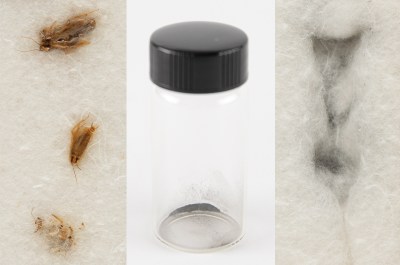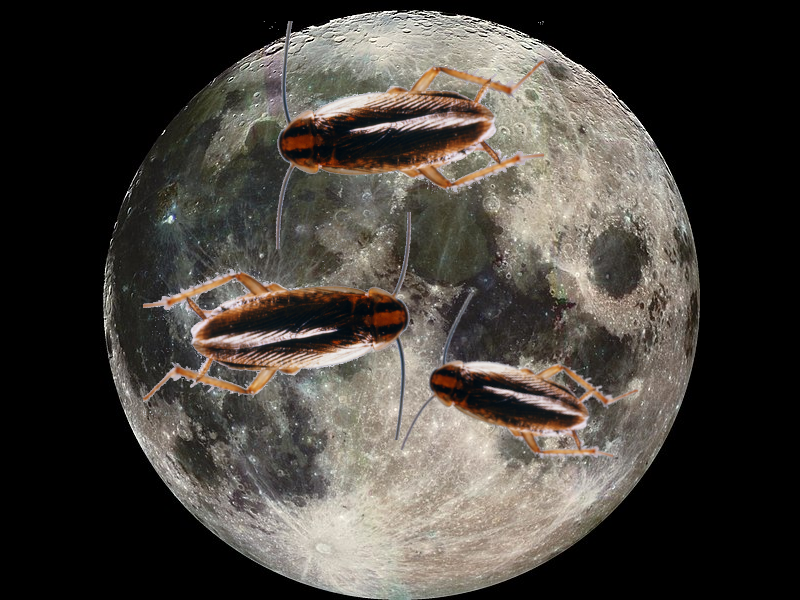News hit earlier this month that the infamous “cockroach moon dust” was up for auction? Turns out, NASA is trying to block the sale as they assert that they own all the lunar material brought back from the Apollo missions. What? You didn’t know about cockroach moon dust? Well, it is a long and — frankly — weird story.
It may sound silly now, but there was real concern in 1969 that Apollo 11 might bring back something harmful. So much so that NASA tricked out an RV and kept the astronauts and a volunteer in it for about three weeks after they came home. During that time they were tested and some experiments were done to see if they’d been exposed to anything nasty.
One of those experiments was to feed lunar dust to cockroaches (by the way, the table of contents has a mistake in it — check out page 8). Seriously. But that isn’t even the really weird part. A scientist who worked on the project by the name of Marion Brooks decided she wanted a memento, so she extracted the lunar dust from the dead cockroaches and saved it in a vial. At least we learned a new word: chyme.
RR Auction — the RR stands for Remarkable Rarities — was starting the bidding for some dead cockroaches and a vial of chyme at about 12 grand but it was sure to go higher than that, perhaps up to $400,000 USD. That was before they got a cease and desist from NASA.
 It appears the collection has been sold at least once before. NASA has cracked down on anyone selling lunar material as even those given to people are considered on loan from the agency. However, many of the rocks given to different countries and state governments are now unaccounted for.
It appears the collection has been sold at least once before. NASA has cracked down on anyone selling lunar material as even those given to people are considered on loan from the agency. However, many of the rocks given to different countries and state governments are now unaccounted for.
Back in 2002, interns Thad Roberts and Tiffany Fowler worked in the building where NASA stores most of the moon rocks it has. They took a 600-pound safe containing about 100 grams of moon samples and some other materials. With some help, Roberts tried to fence them to an amateur rock collector who helped the FBI set up a sting. Roberts got over 8 years in federal prison for his efforts, just a little more than an accomplice, Gordon McWhorter, who claimed to have been duped by Roberts. There have been a few other cases of theft, most of which remain unsolved.
This is one of those tricky things. From NASA’s point of view, they own all the moon rocks (with a few exceptions, mostly of material that didn’t come from Apollo). If you steal them, they want them back and if you are given them on loan they don’t appreciate you giving them away, selling them, or losing them. On the other hand, outside of outright theft like the Roberts case, it is hard to imagine that you want to control old roach chyme.
There’s two things we do wonder. First, who saves roach chyme even if it did start as lunar dust? Second, if three little pebbles brought back by the Soviet Luna 16 probe sold for over $850,000 and this dust might have gone for $400,000, why aren’t more of these “New Space” startups scrambling to bring some fresh samples back? Seems like it might pay for itself.
















One thing I have been trying to figure since this story broke. Moons dust is sharp right, what the heck did they expect to happen feeding it to roaches, would have been like feeding them diatomaceous earth, scratch their guts up and kill them by dehydration. (Larger vertebrates survive it though)
Brooks commented she expected the same but said it didn’t hurt them at all. Roaches are tough!
Still seems a bit of a flawed experiment though, like “Let’s test if this substance has toxic levels of arsenic in it, by mixing it with shards of razor blade and feeding it to something.”
I was just thinking that if I needed a canary in my coal mine, I wouldn’t choose an animal that can live without air for 40 minutes, tolerate ten times the radiation that will kill a human, and live a week or more without its own head.
True, seems like the same kind of thinking as sticking an inch and a half of brass rod in your fuseholder, because you only want it to blow if something is really, really, really wrong.
what the phuk? seriously? for a bit of crumbled rocks they had no idea were missing for how many decades?
It would make sense if they thought something else had been on the moon and they don’t know what forensics it might have left in the dirt….
One question arises: How can NASA claim ownership of moon dust? After all, they didn’t ask the rightful owner before taking away some of it and leaving a mess in the Mare Tranquillitatis.
NASA, probably worked out a deal beforehand with the aliens living in the hollow Moon.
I agree, but I’d assume they mean, all pristine moon dust/dirt/rocks on earth, which should really be changed to: “all extraterrestrial samples recovered as a part of a NASA mission belong to NASA.”
The saddest thing of it all is that there are too many people who have so much money they do not know what to do it anymore and they thing buying some dust for half a million is a good idea.
Probably just gonna cut it and sell baggies on the street :-D
Technically, it still has more intrinsic value than NFTs…
Regarding your startup idea: Moon dust is expensive because the supply is really limited. If you start a company and manage to bring a lot of moon dust to earth, it would become worthless.
Oh yeah, like diamonds and De Beers?
I can see the marketing already: “Moon dust is a girl’s best friend”
Just hear me out….. Diamonds made from compressed moon dust!!
The process to do that would be more valuable than the product, since it would presumably require transmutation of the elements due to nothing more than trace amounts of carbon on the moon according to what we currently know.
Something that came back in the 2000s isn’t going to be nearly as rare as something that came back in 1900
Going forward, maybe, but how many returning moon missions have we had in the last 2 decades vs the great Apollo push??
Yeah. We’ve institutionally lost the competence required for manned missions up there since the 60s/70s. It’s not very popular to talk about.
It’s almost as though the Jack Welch-ification of the aerospace industry has killed long term centers of talent…
According to https://en.wikipedia.org/wiki/Lunar_soil
360kg cam back with Apollo and the only amount since was 2kg by Chang’e-5 mission. Hence recent moon goop (dust/soil/rock whatevs) is very much rarer.
It is also said that due to atmospheric contamination, the NASA holdings are scientifically worthless.
One can always go with the, “an astronaut touched this” to boost the ratings.
Where did NASA receive it’s funding for the Apollo missions? I’d say every single nanogram of material brought back from the moon is rightfully owned by American citizens. So NASA, where’s my 1 ng of moon dust, hmm?
You can go touch it at the Kennedy Space Center Visitor Complex? Admission isn’t free but you can touch a moon rock (and see lots of other cool stuff).
All your samples are belong to us.
“if three little pebbles brought back by the Soviet Luna 16 probe sold for over $850,000 and this dust might have gone for $400,000, why aren’t more of these “New Space” startups scrambling to bring some fresh samples back? Seems like it might pay for itself.”
Quick back of the envelope guesses:
Chang’e-5 returned lunar samples, so it’s a good model of modern lunar technology, it weighed about 8000kg. That’s roughly the payload for a Falcon 9 out to GEO. So we’ll assume that you can probably fit a whole lunar sample return mission on a F9, which would cost you roughly $60M
The spacecraft as a whole is probably going to be on the pricey side, there’s not much in the way of public numbers, but if a large communications satellite costs $500M, we can guess it’ll cost at least that for our spacecraft.
So that puts our total costs somewhere in the $600M range (although once you’ve paid your employees, and all the costs of recovering the returned samples etc, I doubt you’d get much change out of $1B).
Chang’e-5 returned ~1.7kg, and lunar rock is estimated to be worth ~$4M/g, so if you didn’t crash the market, you could be making in the region of $6B from selling your samples.
So yes, on the face of it, returning moon rocks *might* be a viable business.
Reminds me of the beginning of “Moonseed”.
https://en.wikipedia.org/wiki/Moonseed_(novel)